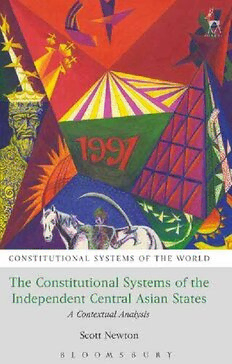
The Constitutional Systems of the Independent Central Asian States: A Contextual Analysis PDF
365 Pages·2017·2.608 MB·English
Most books are stored in the elastic cloud where traffic is expensive. For this reason, we have a limit on daily download.
Preview The Constitutional Systems of the Independent Central Asian States: A Contextual Analysis
Description:
This book undertakes the first comparative constitutional analysis of the Kyrgyz Republic and Republics of Kazakhstan, Turkmenistan, Uzbekistan and Tajikistan in their cultural, historical, political, economic and social context. The first chapter provides a general overview of the diverse and dynamic constitutional landscape across the region. A second chapter examines the Soviet constitutional system in depth as the womb of the Central Asian States. A third chapter completes the general picture by examining the constitutional influences of the ‘new world order’ of globalisation, neo-liberalism and good governance into which the five states were thrust. The remaining five chapters look in turn at the constitutional context of presidents and governments, parliaments and elections, courts and rights, society and economy, and culture and identity. The enquiry probes the regional patterns of neo-Sovietism, plebiscitary elections, weak courts and parliaments, crony capitalism and constraints on association, as well as the counter-tendencies that strengthen democracy, rights protection and pluralism. It reveals the Central Asian experience to be emblematic of the principal issues and tensions facing contemporary constitutional systems everywhere.Pictorial NarrativeThe Independent Central Asian Republics: Mythical Frontiers.The Romanov Imperial crown on double-headed eagle, to the left, and Soviet Union’s sickle and hammer with red star, to the right, converge on a yurt etched with the year 1991. This part of the composition refers to the continuous Russian political dominance from the 19th century up to 1991 when the Central Asian Republics achieved independence. Over the yurt, the crescent moon with rising star symbolises Islam, the common religion of the Republics.To the right Tamerlane(), the iconic founder of the Timurid Empire, recalls the medieval Turco-Persian splendour of the ‘heart of the world.’ Tajikistan’s flag forms part of Tamerlane’s crown—a blazing sun radiates from Kyrgyzstan’s flag and envelopes his left arm. Adjoining the yurt is Norman Foster’s Pyramid of Peace and Accord in Astana (capital of Kazakstan). Uzbekistan’s flag occupies the other side of the pyramid. Kazakstan’s flag is stretched across the bottom right corner. Turkmenistan’s flag is spread in front of the pyramid. The composition concludes with a solitary swordsman and his white horse() under a starry night—capturing the nomadic past of the steppes and the spirit of adventure.PutachadArtist
See more
The list of books you might like
Most books are stored in the elastic cloud where traffic is expensive. For this reason, we have a limit on daily download.
